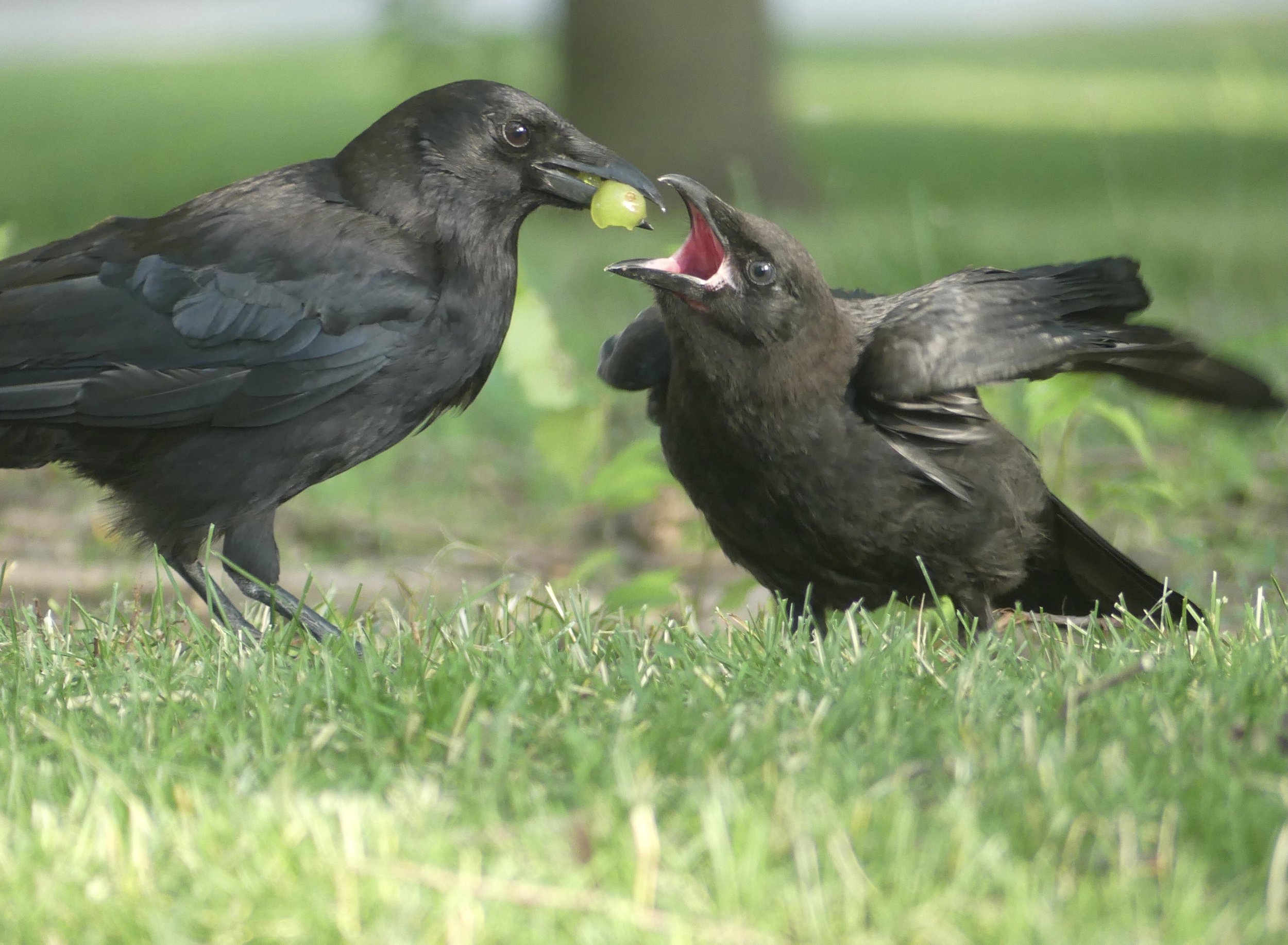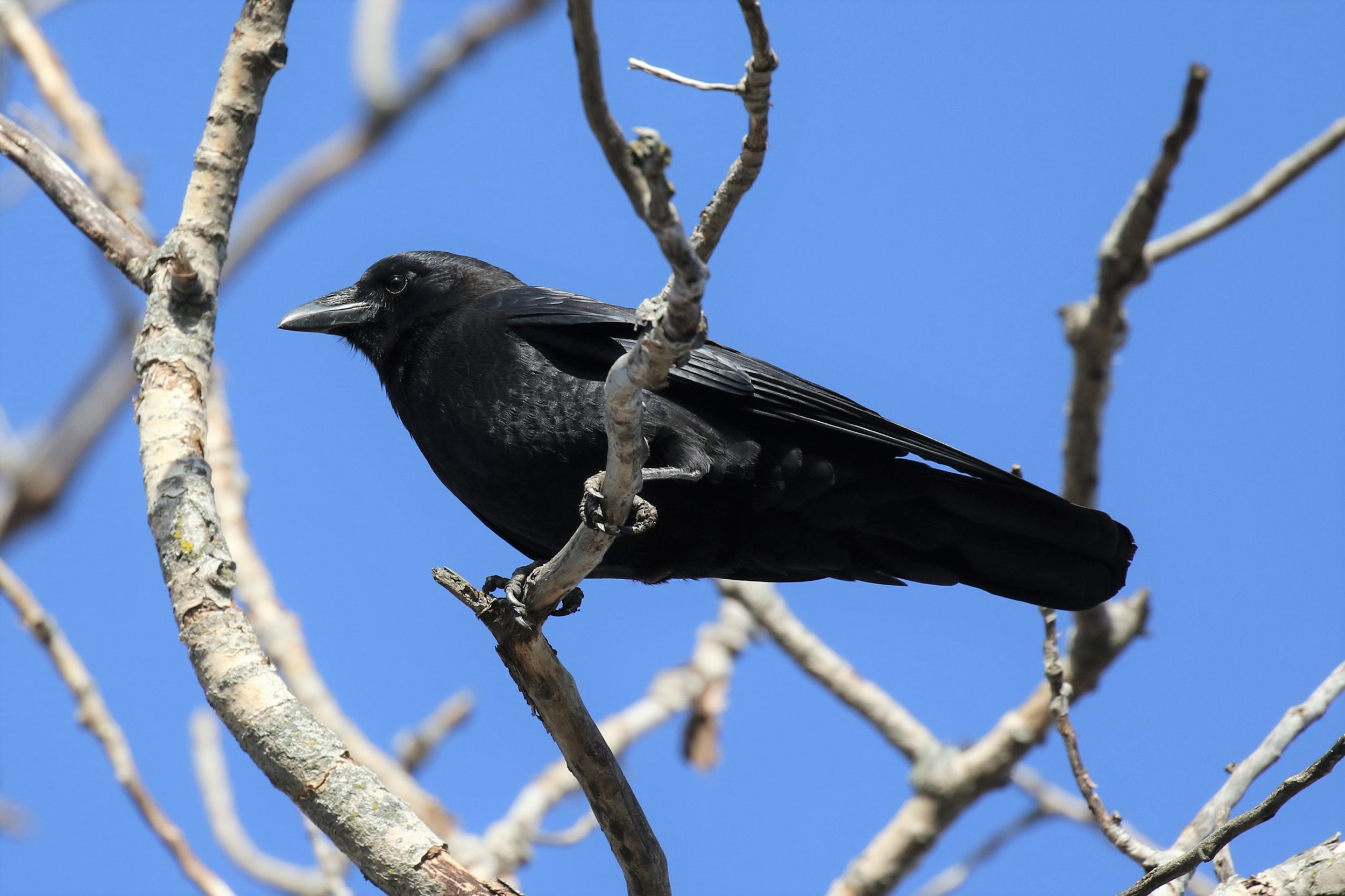Saving Our Murders
West Nile has devastating effects on crow populations, but many are determined to help
This story originally appeared in the Oct/Nov 2022 edition of The Chicago Birder, COS's bi-monthly member magazine. For more information about The Chicago Birder and other membership benefits, take a look at our membership page.
by Kris Hansen
When Michele DiBernardo moved to Chicago from upstate New York, she missed American Crows so much that she set out to befriend her own flock, called a murder.
“When you find out how smart they are, you want to be their friend. I thought I’d give it a shot. Are they going to remember me wearing a mask, wearing different outfits?” she recalls. She started to feed crows on her way to North Pond in Lincoln Park on her morning walks. “It got to the point where I would leave them food and keep walking, and they would eat the food and then follow me. Oh, they like me!”
Sofie Zivovic, who moved from Boston to Chicago eight years ago, told her real estate agent she needed a home with a yard suitable for crows. “She must have thought I was crazy, but she rolled with it, and within months of moving in I was feeding the neighborhood murder.”
Photo Alex Muench
Their shared passion for crows led DiBernardo and Zivovic to became crow rescue specialists for the Chicago Bird Collision Monitors (CBCM), a volunteer conservation group dedicated to bird rescue and advocacy. Their work became exponentially more awful, and rewarding, when West Nile virus surged in Chicagoland in 2017. Carried by the Culex Mosquito, West Nile is almost 100 percent deadly in American Crows, and most infected crows die before they can be transported to a wildlife rehabilitation center.
“I would rather they die with me than alone on the ground,” says DiBernardo, who has cared for dozens of dying crows, including some from her own murder. “It’s bad, but it’s rewarding. It’s 100 percent worth the heartbreak.”
Uniquely susceptible to West Nile
“Our crow species, and corvids in general, are one of the most susceptible if not the most susceptible to West Nile,” says Sarah Reich, staff veterinarian for Willowbrook Wildlife Center in Glen Ellyn, IL. “The majority come in dying already. Many don’t make it through the door.”
Zivovic, the CBCM volunteer, says that by the time a sick crow is spotted and rescued, the disease has already progressed too far. “I think there is this window of time where, if supportive care is available, they can survive. We’re going to keep trying to get them that care in time.”
The summer of 2022 has seen another surge in cases of West Nile in crows. Of the 60 crows brought to Willowbrook with suspected West Nile, only one recovered, Reich says. And, although the bird’s symptoms were consistent with West Nile, it’s possible that crow did not have West Nile. “There is just so much that we don’t know about this disease,” she says.
Photo Michelle DiBernardo
West Nile inflames tissues throughout the body, including the brain. “A healthy crow is loud, aggressive, and very active,” Reich says. “An infected crow is unusually quiet. Or you can have overt neurologic signs—they’re wobbly, they’re drunk-walking, they’re falling off their perches, trembling, all the way up to full-blown seizures.”
Zivovic says that when a crow is infected, “their wings and feet have intense seizures. If you put them in a box and leave them somewhere quiet, they are literally banging around in the box and hurting themselves. I put them on a towel on the floor so they have more open space and can look around. When a seizure hits, they literally cartwheel across the floor.”
Many bird species, such as doves and robins, get infected and never show symptoms. About half of the raptors and waterfowl brought to Willowbrook with suspected West Nile recover. However, until a crow in a laboratory setting recovered from West Nile in 2021, there were no scientifically documented instances of a crow surviving West Nile.
Willowbrook does not test for West Nile because of the expense and because test results don’t change the treatment. “The reality is, with these species and the clinical signs and this time of year, you can say almost certainly that this is a West Nile bird,” Reich says. “It’s an inflammatory disease and it’s a virus. All you can do is care for them supportively and treat the inflammation.”
Racing across the continent
West Nile first arrived in North America in 1999, says Kevin McGowan, an ornithologist with the Cornell Lab of Ornithology.
“I was one of the first people to realize that there was a new disease on our shores,” McGowan says. While he was getting calls about large numbers of dead crows on Long Island, humans were being diagnosed with West Nile.
“If it is the same thing, then it's something we've never seen before,” he told a wildlife pathologist that he urged to test for West Nile. “It turned out I was right.”
Not that he took any pleasure in that. McGowan has studied crows since 1989, banding and tracking more than 3,000 individuals in the area. By 2003, half the crows in New York had died of West Nile.
“There were birds I'd known since they were an egg,” McGowan says. “I’m a biologist, and I'm a realist…but still it's hard to disassociate yourself from putting in so much work and time getting to know individuals and then finding them dead or watching them die.”
Photo Michell DiBernardo
The devastation rolled west across North America. In 2003, researcher Sarah Yaremych estimated that 75 percent of the crows in Illinois had died of West Nile. Similar numbers were reported in Oklahoma. That same year, West Nile was reported in birds in California.
Then the crows caught a break. There were only a few isolated outbreaks during the next decade, and the population rebounded.
In 2012, “West Nile came back with a vengeance,” McGowan says. “We lost 30 percent to 40 percent of our population in New York again.” Once again the crows started rebuilding. Then, in 2017, there was another widespread outbreak. “We lost half of the crows we had left.”
Since then, the prevalence of West Nile has followed the weather and the breeding conditions for the Culex Mosquito, says Reich. Mosquito populations start rising in July and peak in August and September.
“So far [in 2022] we’ve had 47 suspected cases in crows and raptors. Last year we had 27 total. The year before we had 43, and before that 15. The fact that we’re already at 47 [in mid-September] and we’re not through the season is not boding well for this year,” Reich says.
He’s equally concerned about crows across North America. “With a virus, natural selection happens, and birds will develop resistance, but you have to have some survive first,” he says. Two crows with confirmed West Nile have recovered and been released from the Cornell Lab.
CBCM volunteer Zivovic says, “I’ve heard anecdotally, from rehabbers across the country, that they’ve had crows that survived.” One suce survivor includes Jimini Crowket, the “talking crow” from Messinger Woods Wildlife Care and Education Center in Buffalo, NY.
Photo Michelle DiBernardo
The joy of crows
Zivovic and DiBernardo are committed to helping turn the tide by quickly rescuing ailing crows and removing dead crows so that the virus cannot be transmitted further.
“I had a very Hitchcockian moment with a crow,” Zivovic says. “I picked up a [young crow] that had something wrong with him. I had him in my arms as I was walking home. Other crows spotted us and sent out the call, and the next thing you know there are a dozen crows swirling in the air yelling at me. Yes, I’m that weird woman walking down the street being chased by loud, angry crows.”
Bird lovers should not attempt to pick up an ailing crow, says DiBernardo. “We have both been on the wrong side of a crow beak, and their legs are STRONG. You don’t want to do that unless you know what you are doing.”
Adds Zivovic, “If you want to rescue crows, join the team and we’ll train you so that you know what you are doing.”
Photo Walter Marcisz
Volunteering is a great way to learn just how unusual American Crows are, the volunteers say. They live in family units and stay in the same territory. Offspring live with their parents for several years, helping raise younger siblings. A murder of 10 to 12 crows is likely one family.
“That connection, the way they protect each other and stick together, is unique,” says Zivovic.
“Every crow has its own personality, and they have so MUCH personality. If you aren’t paying attention to your local birds, you are missing so much, and crows exponentially more so,” she continues. “It’s endlessly amusing.”
If you see a dead crow or a crow behaving strangely, contact the Chicago Bird Collision Monitors hotline at 773-988-1867.





